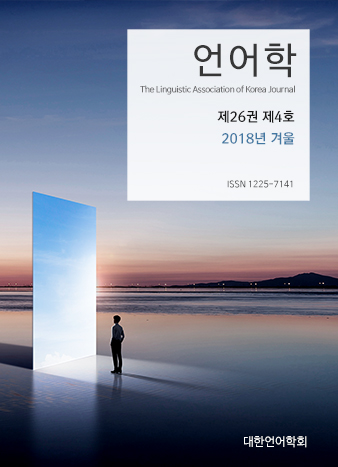대한언어학회 전자저널

-
L1 Interference in Koreans' Perception of Released Word-final Stops in English
-
Perceptual Similarity between English and Korean: Evidence from Online Adaptation
-
A Study on the Definite Article in English Based on the Rasch Model
-
Phonetic Resurrection from Ellipsis Sites: A Case from Pseudo-gapping
-
A Study of the Content Validity of Reading Comprehension Tests in NMET II
-
Labeling, Cartography, and the Left-periphery of Korean Clauses
26권 4호 (2018년 12월)
- A Study on the Definite Article in English Based on the Rasch Model
-
Nayu Kim & Heechul Lee
Pages : 37-54
Abstract
Keywords
# definite article # Rasch model # hierarchy of difficulty
References
- Bond, T. G., & Fox, C. M. (2007). Applying the Rasch model: Fundamental measurement in the human science. New York city: Psychology Press.
- Chung, T. (2009). The role of semantic factors in the acquisition of English articles. English Teaching, 64, 31-52.
- Eun, H. (2008). A genre-based analysis of the introduction sections of English research article. Unpublished doctoral dissertation, Chonbuk National University, Jeonju, Korea.
- Ionin, T., Ko, H., & Wexler, K. (2004). Article semantics in L2-acquisition: The role of specificity. Language Acquisition, 12, 3-69.
- Jung, S., & Park, M. (2013). The processing of specificity in the English article system by Korean learners of English. Studies in Modern Grammar, 74, 155-179.
- Kim, H. (2004). Cognitive linguistic explanatory adequacy on the definite article of English. The Journal of Linguistic Science, 29, 107-124.
- Kim, K. (2006). The interpretation and processing of English articles by native speakers of Korean. Unpublished master's thesis, Southern Illinois University, Carbondale.
- Lee, S., & Uhm. C. (2014). Rhetorical structure of L1 and L2 research article introduction. The Linguistic Association of Korea Journal, 22(2), 155-181.
- Li, M., & Olejnik, S. (1997). The power of Rasch person-fit statistics in detecting unusual response patterns. Applied Psychological Measurement, 21, 215-231.
- Linacre, M. (2009). A user’s guide to WINSTEPS Rasch model computer programs. Chicago: Winsteps. com.
- McNamara, T. (1996). Measuring second language performance. London & New York city: Longman.
- Mizuno, M. (1999). Interlanguage analysis of the English article system: Some cognitive constraints facing the Japanese adult learners. IRAL, 37(2), 127-152.
- Myers, S. (1992). In search of the genuine article: A cross-linguistic investigation of the development of the English article system in the written compositions of adult ESL students. Unpublished doctoral dissertation, Florida State University, Tallahassee.
- Robertson, D. (2000). Variability in the use of the English article system by Chinese learners of English. Second Language Research, 16(2), 135-172.
- Park, K. (2011). Influential factors in integral citation choices in research article introductions. Korean Journal of Applied Linguistics, 27(1), 315-340.
- Samraj, B. (2002). Introductions in research articles: Variations across disciplines. English for Specific Purposes, 21, 1-17.
- Segall, P. (1990). Internalizing English articles. Seoul: Shinronsa.
- Snape, N. (2006). The acquisition of the English determiner phrase by Japanese and Spanish learners of English. Unpublished doctoral dissertation, University of Essex, Colchester.
- Young, R. (1995). Form-function relations in articles in English interlanguage. Amsterdam: John Benjamins.